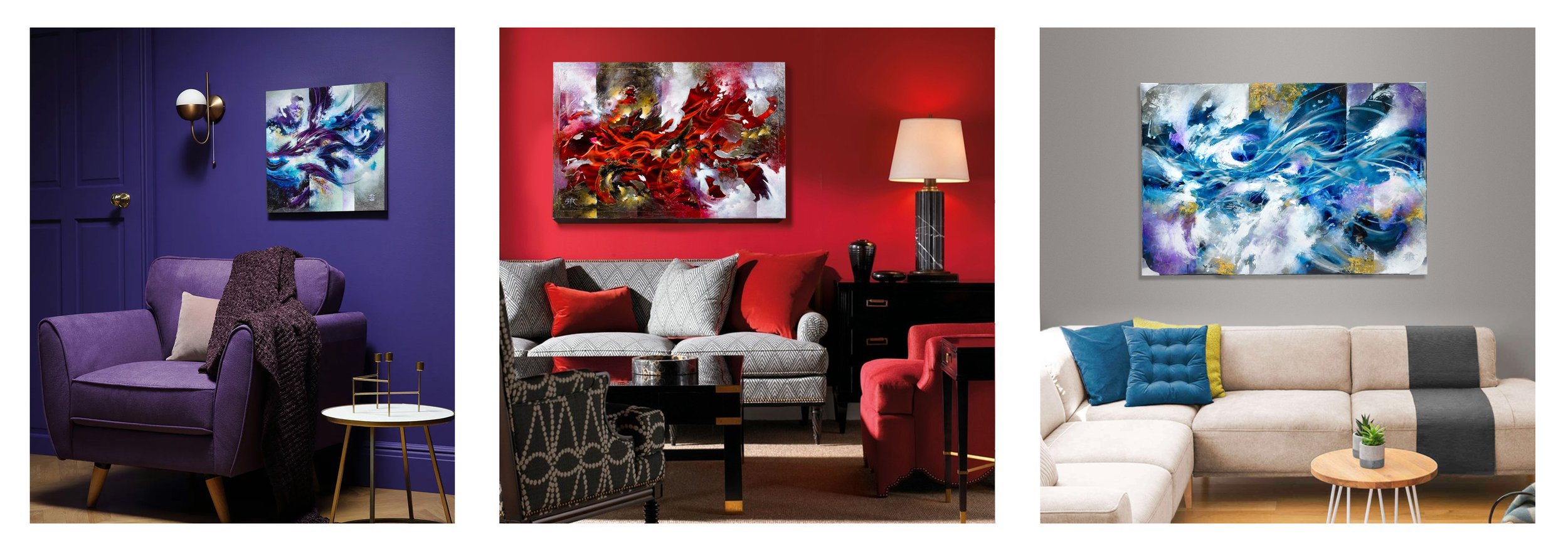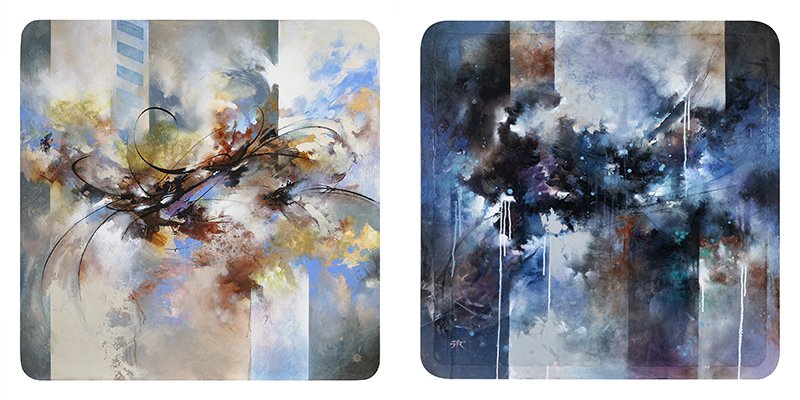Demystifying Abstract Art:
“This Moment Forever” 58 x 36 in. Acrylic on metal, Reverie™
Created for a client to celebrate with his bride the birth of their first child.
In this triptych, the predominant use of golden and earthy tones serves as a symbolic representation of love and prosperity. These colors speak to the couple's journey from marriage to parenthood, embodying the promise of abundance and growth. It's a visual narrative of their enduring love and the bright future that awaits.
Before I begin telling you about what abstract art is, I want to talk about what abstract art isn’t to dispel some myths and common misconceptions that even I once believed to be fact. Abstract art often faces its fair share of criticisms, which stems from the belief that it's simply a chaotic array of shapes and colors devoid of meaning created by people struggling to be perceived as “talented” who simply “aren’t”. And nothing could be further from the truth. So, let's begin by addressing what abstract art is not just to clear the air.
1. What Abstract Art Isn’t:
One of the most pervasive myths about abstract art is the notion that anyone could create it, dismissing it as mere random splatters of paint or thoughtless smudges of color on a canvas. While abstract art can sometimes appear spontaneous, it's far from haphazard. Abstract artists carefully consider the placement of every brushstroke, the choice of colors, and the overall composition to convey their intended message or emotion.
2. It's Not Lacking Skill or Technique:
Another misconception suggests that abstract art is a refuge for artists who lack the technical prowess to create realistic representations. While for some that may be true, but for most it is not. Abstract artists often possess exceptional skill and technique, honed through years of practice and experimentation. They deliberately choose to depart from realism in favor of expressing their creativity and imagination in more uncommon ways.
3. It's Not Devoid of Meaning:
Perhaps the most critical misconception to address is the belief that abstract art is meaningless. Abstract art might not depict concrete objects or scenes, but that doesn't mean it lacks meaning. Instead of representing the external world, abstract art delves into the internal world of emotions, ideas, and concepts. Each stroke, shape, and color is a deliberate choice made by the artist to communicate something collectively more visually profound. To quote Aristotle to drive the point home: “The whole is greater than the sum of its parts”.
Now that we've clarified what abstract art isn't, let's delve into what it truly is and how great abstract art always comports with the principles of color theory and principles of design, shall we? Abstract art is a dynamic genre that transcends the confines of representation, offering viewers a unique visual experience devoid of the hang ups of convention. Abstraction relies heavily on the principles of design and how those associations alone are more than enough to warrant exploration.
Reverie™ hangs in living spaces to demonstrate how abstract art can be incorporated to amplify or compliment the vibe of the room.
1. Abstract Art's Focus on Design Principles:
A. Composition: Abstract art places a strong emphasis on composition—the arrangement of elements within the parameters of artwork’s boundary. Artists meticulously consider how lines, shapes, colors, and textures interact to create a visually compelling and harmonious narrative as a whole.
B. Balance: Balance in abstract art is achieved through a delicate interplay of contrasting elements. Artists seek to strike a balance between symmetry and asymmetry, creating visual tension and interest.
C. Rhythm and Repetition: The use of repetitive patterns or rhythmic elements is common in abstract art. These patterns guide the viewer's eye and create a sense of movement and continuity within the artwork.
D. Proportion and Scale: Artists manipulate proportions and scale to create focal points and emphasize certain elements. This can lead to intriguing visual effects and shifts in perception.
2. Abstract Art as a Vibe, Not a Message:
A. Emotional Expression: Abstract art often communicates emotions, moods, or atmospheres rather than specific messages or narratives. It taps into the artist's inner world, allowing viewers to connect on an emotional level. One that more often than not transcends words.
B. Open to Interpretation: Abstract art invites viewers to bring their own perspectives and interpretations to the table. What one person sees as serenity, another might perceive as chaos. This open-ended quality encourages diverse responses and fosters personal connections with the artwork. Perhaps this also explains abstract art’s mass appeal - the hard and fast rule that there are no rules when it comes to interpretation.
C. Aesthetic Sensibility: Abstract art places a strong emphasis on aesthetics and visual impact. It aims to evoke a visceral response and elicit a sense of connection, wonder or contemplation. It doesn't tell you what to think; it invites you to feel or to experience its impact for yourself first hand.
D. Unveiling Complexity: While abstract art may seem simple at first glance, it often conceals layers of complexity. Subtle details and nuances emerge upon closer inspection, rewarding those who take the time to explore its depths who are forearmed with the knowledge insights you also know now too.
3. A Language of Abstraction:
Abstract art can be likened to a language of abstraction—a form of visual communication that transcends words and traditional representations. It allows artists to convey the ineffable, to speak in colors, shapes, and textures, creating a profound connection with viewers.
Two abstract paintings similar in compositon but very different in visual tone (vibe).
”A Flourish of Hope” - Left
”Silver Linings” - Right
In the realm of abstract art, there are no definitive answers or fixed meanings. Instead, there is an ongoing dialogue between the artist, the artwork, and the viewer—a conversation that evolves with every encounter. Abstract art challenges us to embrace ambiguity, celebrate individuality, and explore the limitless possibilities of human expression. - At least as far as I can tell.
- Billy Rhyze


